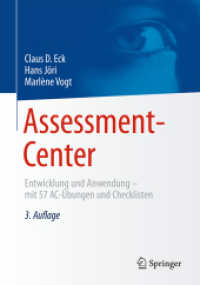- ホーム
- > 洋書
- > 英文書
- > Psychology
基本説明
Provides an introduction to the scientific study of human memory with an emphasis on both the major theories of memory and the laboratory studies that have been used to test those theories and inspire their further development.
Full Description
Foundations of Human Memory provides an introduction to the scientific study of human memory with an emphasis on both the major theories of memory and the laboratory studies that have been used to test those theories and inspire their further development. Written with the undergraduate student in mind, the text assumes no specific background in the subject, but a general familiarity with scientific method and quantitative approaches to the treatment of data. Foundations of human memory is organized around the major empirical paradigms used to study memory in the laboratory and the theories used to explain data obtained using those paradigms. The text begins with a focus on memory for individual items, building up to memory for associations between items, and finally to memory for entire sequences of items and the problem of memory search. Several major theories of memory are considered in detail, including strength theory, summed-similarity theory, neural network based theories, retrieved-context theory, and theories based on the division of memory into separate short-term and long-term storage systems. The text emphasizes basic research over applied problems, but brings in real-world examples and neuroscientific evidence as appropriate.
Contents
1 Introduction ; 1.1 Historical Background ; 1.2 Association, Context, and Episodic Memory ; 1.3 Methods Used in Studying Memory ; 1.4 The Laws of Repetition and Recency ; 1.5 Cognitivism ; 1.6 Organization of the Book ; 2 Item Recognition ; 2.1 Strength Theory ; 2.2 Multiple Sources of Strength? ; 2.3 Major Findings Concerning Item Recognition ; 2.4 Sternberg's Procedure ; 2.5 Summary and Current Directions ; 2.6 Study Questions ; 3 Attribute Models ; 3.1 Attributes ; 3.2 A Multi-trace Distributed Memory Model ; 3.3 Similarity Effects ; 3.4 The Diffusion Model of Reaction Time ; 3.5 Context Revisited ; 3.6 Summary and Current Directions ; 3.7 List-strength Effect ; 3.8 A Unitrace Attribute Model ; 3.9 Study Questions ; 4 Associations and Cued Recall ; 4.1 Major Associative Tasks ; 4.2 Encoding and Repetition ; 4.3 Recency and List Length ; 4.4 Retrieval Errors ; 4.5 Retroactive Interference and Recovery ; 4.6 Proactive Interference ; 4.7 Context and Interference Theory ; 4.8 Similarity and Interference ; 4.9 Unlearning as Inhibition ; 4.10 Interference Theory: Concluding Remarks ; 4.11 Item and Associative Information ; 4.12 Summary and Current Directions ; 4.13 Study Questions ; 5 Models of Association ; 5.1 The Attribute-Similarity Framework ; 5.2 Neural Network Models ; 5.3 Summary and Current Directions ; 5.4 More on Linear Associators ; 5.5 Project: Cued Recall in a Hopfield Net ; 5.6 Study Questions ; 6 Free Recall and Memory Search ; 6.1 Serial-position Effects ; 6.2 Retrieval Dynamics ; 6.3 Semantic Clustering ; 6.4 Intrusions ; 6.5 Repetition Effects ; 6.6 Summary and Current Directions ; 6.7 Study Questions ; 7 Models of Free Recall ; 7.1 Dual-store Memory Search Models ; 7.2 Testing Dual-Store Models ; 7.3 Problems for Dual-store Models ; 7.4 Single-store retrieved-context models ; 7.5 Testing Retrieved Context Theory ; 7.6 Summary and Current Directions ; 7.7 Study Questions ; 8 Sequence Memory ; 8.1 Serial Recall and Memory Span ; 8.2 Serial-Position Effects ; 8.3 Modality and Suffix Effects: Evidence for a phonological STS? ; 8.4 Recall Errors ; 8.5 Associative Asymmetry ; 8.6 Grouping Effects ; 8.7 Summary and Current Directions ; 8.8 Study Questions ; 9 Theories of Sequence Memory ; 9.1 Associative Chaining ; 9.2 Positional Coding ; 9.3 Eight Critical Findings ; 9.4 Chaining vs. Positional Coding ; 9.5 Hierarchical Associative Theory ; 9.6 Summary and Current Directions ; References ; Author Index ; Index








